Content for TS 23.379 Word version: 19.5.0
1…
7…
10…
10.5…
10.6…
10.6.2.3…
10.6.2.4…
10.6.2.5…
10.6.2.6…
10.6.2.9…
10.6.3…
10.7…
10.7.3…
10.7.5…
10.7.6…
10.9…
10.9.1.3.3…
10.9.1.4…
10.9.2…
10.10…
10.12…
10.19…
10.19.3…
10.19.3.1.4…
10.19.3.2…
10.19.3.2.4…
10.19.3.2.6…
A…
10.6.2.5 Broadcast group call
10.6.2.5.1 General
10.6.2.5.2 Common broadcast group call procedure
10.6.2.5.4 Group call for broadcast temporary groups across multiple MCPTT systems
...
...
10.6.2.5 Broadcast group call p. 74
10.6.2.5.1 General p. 74
A broadcast group call is a special group call where the initiating MCPTT user expects no response from the other MCPTT users, so that when his transmission is complete, so is the call.
10.6.2.5.2 Common broadcast group call procedure p. 74
The group-broadcast group and the broadcast regrouped group are similar in structure (a collection of groups). Similarly the user-broadcast group and the pre-arranged group (a collection of users) are similar in structure. Only the call originator can transmit media during the broadcast group call and the broadcast group call is released when the transmission is complete, unless the call originator is overridden.
Figure 10.6.2.5.2-1 illustrates the common procedure for broadcast group call on group-broadcast group, user-broadcast group and broadcast regrouped group and pre-arranged groups.
Pre-conditions:
- MCPTT client 1 and MCPTT client 2 are members of a pre-arranged broadcast group/user-broadcast group/broadcast regroup group.
- Optionally, MCPTT client 1 may have an activated functional alias for the group communication.
- The MCPTT server may have subscribed to the MCPTT functional alias controlling server within the MC system for functional alias activation/ de-activation updates.
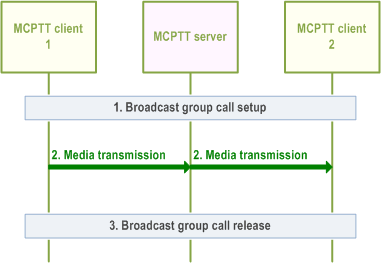
Step 1.
MCPTT user at MCPTT client 1 initiates the broadcast group call setup procedure with the indication of broadcast group call. The signalling procedure is identical to the group call setup as described in subclause 10.6.2.3 with the inclusion of the parameter for broadcast group call indicator. The MCPTT user at MCPTT client 1 may include a functional alias used for the broadcast group call and the MCPTT server checks whether the provided functional alias can be used and has been activated for the MCPTT user.
Step 2.
MCPTT client 1 starts to transmit media.
Step 3.
If the media transmission from call originating MCPTT user is complete, the broadcast group call is released.
10.6.2.5.2.1 Group-broadcast group call procedure p. 75
The group-broadcast group is defined as a set of groups, not a set of MCPTT users. The group-broadcast group is also defined with a hierarchy. It is expected that the MCPTT user that originates the group-broadcast group call is the only one transmitting media during the group-broadcast group call and that the group-broadcast group call is terminated when the transmission is complete. However, if the override feature is enabled, then the call originator may be overridden.
Figure 10.6.2.5.2.1-1 illustrates the procedure for group-broadcast group call establishment.
Pre-conditions:
- The group (e.g. A) to which MCPTT client 1 and MCPTT client 2 are members is a subordinate group of the group-broadcast group (i.e., the group-broadcast group was defined with group A as a subordinate group).
- The group (e.g. A) currently has an on-going MCPTT group call that is not an MCPTT emergency group call.
- The call initiator of the group-broadcast group is a member of another group (e.g., X, not group A) which is also a subordinate group of the group-broadcast group (i.e., the group-broadcast group was defined with group X as a subordinate group).
- The group-broadcast group and its subordinated groups are defined in the same group management server and served by the same MCPTT server.
- Optionally, MCPTT client 3 may have an activated functional alias for the group communication.
- The MCPTT server may have subscribed to the MCPTT functional alias controlling server within the MC system for functional alias activation/de-activation updates.
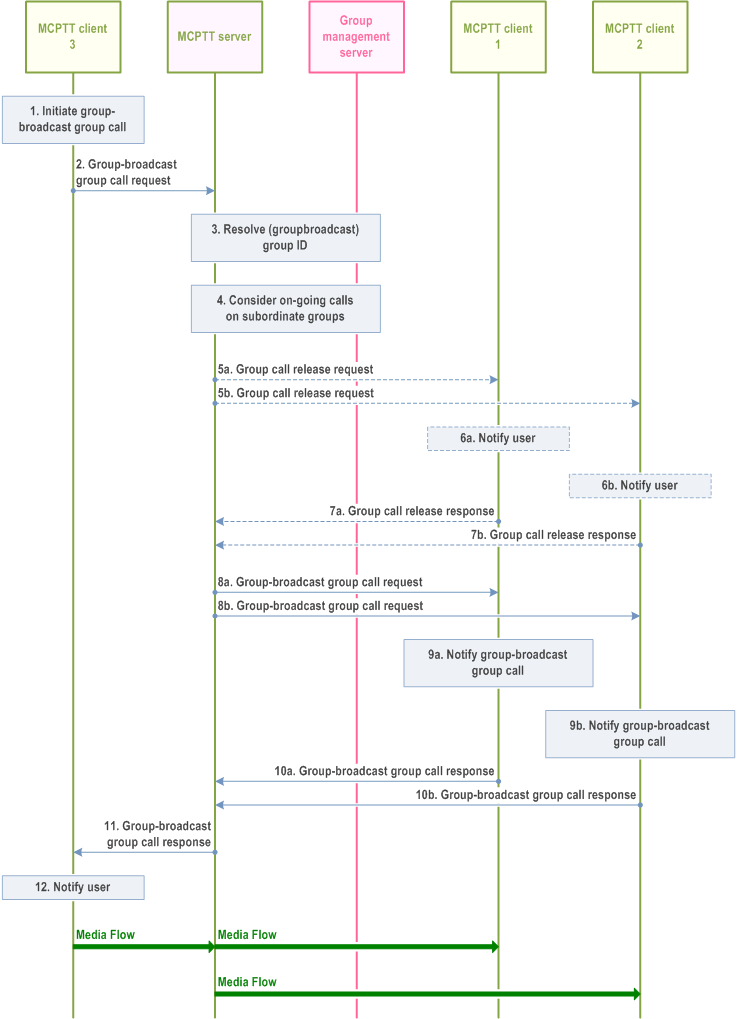
Step 1.
Resources are now available for the transmission from MCPTT client 3 to MCPTT client 1 and MCPTT client 2. Once the user of MCPTT cleint 3 completes transmitting, the group-broadcast group call is releases as are the resources.
MCPTT user at MCPTT client 3 initiates the group-broadcast group call setup procedure.
Step 2.
The MCPTT client 3 sends a group-broadcast group call request to the MCPTT server. The MCPTT user at MCPTT client 1 may include a functional alias used for the broadcast group call.
Step 3.
The MCPTT server checks whether the provided functional alias can be used and has been activated for the MCPTT user. The MCPTT server needs to resolve the group-broadcast group ID into its subordinate groups in order to contact the affiliated MCPTT users of those subordinate groups.
Step 4.
The MCPTT server then needs to consider any on-going group calls on those subordinate groups because this may affect the behaviour for what happens next. In this case a group call exists on a subordinate group. Thus, the MCPTT users involved in the group call on this subordinate group.
Step 5.
Optionally the on-going group call on a subordinate group may be terminated in which case the MCPTT client 1 and MCPTT client 2 need to be sent a Group call release request.
Step 6.
The MCPTT client 1 and MCPTT client 2 then notify their users of the group call release request.
Step 7.
The MCPTT client 1 and MCPTT client 2 respond to the group call release request by sending a group call release response.
Step 8.
A group-broadcast group call request is sent to both the MCPTT client 1 and the MCPTT client 2. The request may contain the functional alias of the calling party.
Step 9.
MCPTT client 1 and MCPTT client 2 notify their users of the incoming group-broadcast group call. The functional alias of the calling party, if available, is presented to the users.
Step 10.
MCPTT client 1 and MCPTT client 2 respond to the group-broadcast group call request by sending a group-broadcast group call response.
Step 11.
The MCPTT server responds to MCPTT client 3 (the call initiator) that the group-broadcast group call has been established by sending a group-broadcast group call response.
Step 12.
The MCPTT client 3 notifies its user that the user can begin transmitting using the group-broadcast group call resources.
10.6.2.5.2.2 Group-broadcast group call procedure when a subordinate group has an on-going MCPTT emergency group call p. 77
The group-broadcast group is defined as a set of groups, not MCPTT users. The affiliated MCPTT group members of a subordinate group with an on-going MCPTT emergency group call are not interrupted by a group-broadcast group call.
Figure 10.6.2.5.2.2-1 illustrates the procedure for group-broadcast group call when a subordinate group has an on-going MCPTT emergency group call.
Pre-conditions:
- MCPTT The group (e.g. A) to which MCPTT client 1 and MCPTT client 2 are members is a subordinate group of the group-broadcast group (i.e., the group-broadcast group was defined with group A as a subordinate group).
- The group (e.g. A) currently has an on-going MCPTT emergency group call.
- The call initiator (user of MCPTT client 3) of the group-broadcast group is a member of another group (e.g., X, not group A) which is also a subordinate group of the group-broadcast group (i.e., the group-broadcast group was defined with group X as a subordinate group).
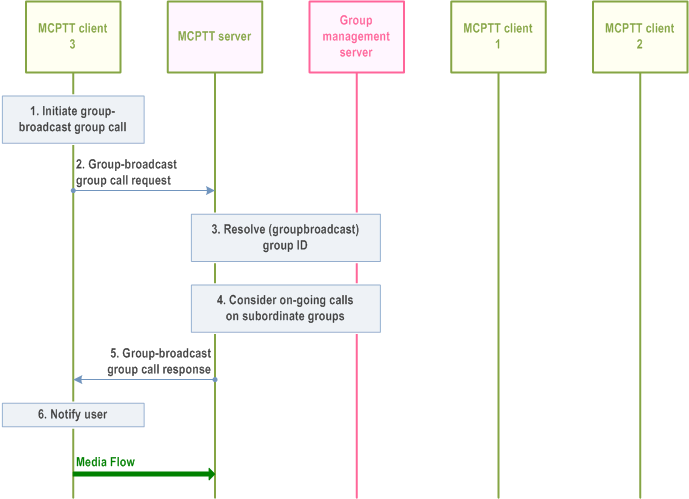
Step 1.
Resources are now available for the transmission from MCPTT client 3 to the MCPTT clients (not shown) of other subordinate groups (i.e., not A). Once the user of MCPTT cleint 3 completes transmitting, the group-broadcast group call is releases as are the resources.
The MCPTT user at MCPTT client 3 initiates the group-broadcast group call setup procedure.
Step 2.
The MCPTT client 3 sends a group-broadcast group call request to the MCPTT server.
Step 3.
The MCPTT server needs to resolve the group-broadcast group ID into its subordinate groups in order to contact the affiliated MCPTT group members of those subordinate groups.
Step 4.
The MCPTT server then considers any on-going group calls on those subordinate groups (e.g. A) because this may effect the behaviour for what happens next. In this case an emergency group call exists on a subordinate group.
Step 5.
The MCPTT server responds to the call initiator that the group-broadcast group call has been established.
Step 6.
The MCPTT client 3 notifies its user that the user can begin transmitting using the group-broadcast group call resources.
10.6.2.5.2.3 Group-broadcast group call release procedure p. 78
When the call originator has completed transmitting, the group-broadcast group call is terminated and resources released.
Figure 10.6.2.5.2.3-1 illustrates the procedure for group-broadcast group call release.
Pre-conditions:
- An on-going group-broadcast group call involving MCPTT client 1, MCPTT client 2, and MCPTT client 3 exists.
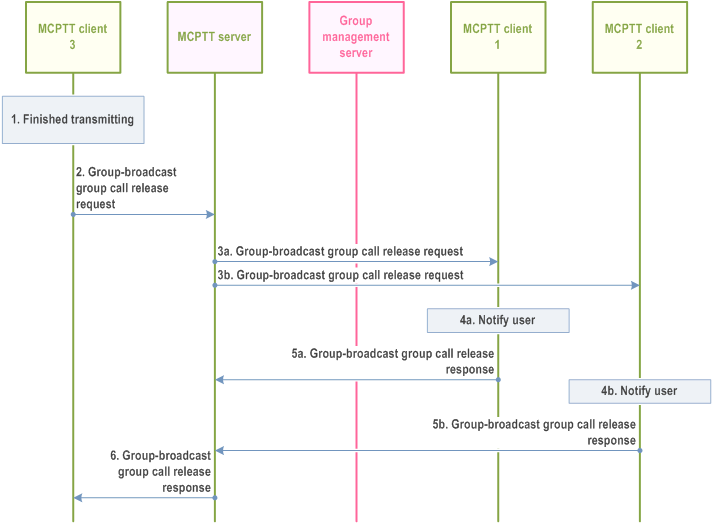
Step 1.
MCPTT user on MCPTT client 3 finished transmitting.
Step 2.
A group-broadcast group call release request is sent to the MCPTT server of the group-broadcast group.
Step 3.
The MCPTT users of MCPTT client 1 and MCPTT client 2 of the group-broadcast group's subordinate groups are sent a group-broadcast group call release request
Step 4.
MCPTT client 1 and MCPTT client 2 notify their users that the group-broadcast group call has ended.
Step 5.
MCPTT client 1 and MCPTT client 2 respond to confirm the release of the group-broadcast group call by sending a group-broadcast group call release response.
Step 6.
The MCPTT server sends a group-broadcast group call release response indicating to the initiator that the call is now terminated.
10.6.2.5.2.4 Server-initiated broadcast group call release procedure p. 79
In a broadcast group call, when the call originator has completed transmitting, the MCPTT client releases the floor. Upon receiving the floor release message the MCPTT server then determines if the broadcast call should be released.
Figure 10.6.2.5.2.4-1 illustrates the procedure for server-initiated broadcast group call release.
Pre-conditions:
- An on-going broadcast group call involving MCPTT client 1, MCPTT client 2, and MCPTT client 3 exists.
- MCPTT client 3 is transmitting.
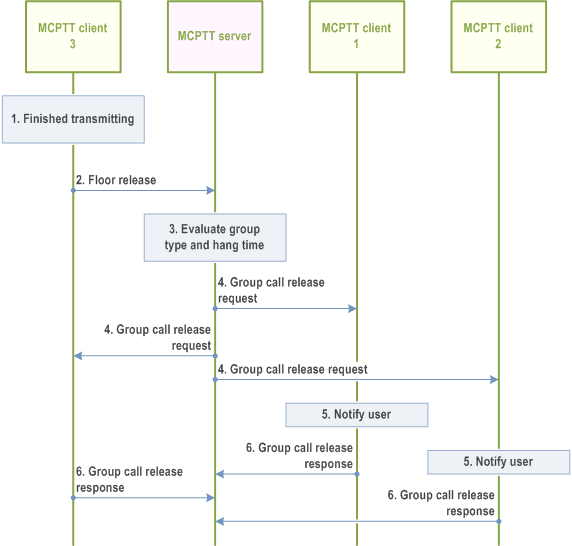
Step 1.
MCPTT user on MCPTT client 3 finished transmitting.
Step 2.
MCPTT client 3 sends a Floor release message to the MCPTT server of the group.
Step 3.
The MCPTT Server determines that the group is a broadcast group and decides that the call should be released.
Step 4.
The MCPTT server sends a Group call release request to MCPTT clients 1, 2, and 3.
Step 5.
MCPTT client 1 and MCPTT client 2 notify their users that the group call has ended.
Step 6.
MCPTT clients 1, 2, and 3 respond to confirm the release of the group call by sending a group call release response.
10.6.2.5.3 Void
10.6.2.5.4 Group call for broadcast temporary groups across multiple MCPTT systems |R16| p. 80
Figure 10.6.2.5.4-1 illustrates the procedure for broadcast temporary group calls across multiple MCPTT systems.
Pre-conditions:
- The security aspects of sharing the user information between primary and partner MCPTT systems shall be governed as per the service provider agreement between them. In this case, we consider the partner MCPTT system does not share their users' information to the primary MCPTT system.
- A broadcast temporary group is formed on the MCPTT server of the primary MCPTT system by an authorized MCPTT user (e.g. dispatcher) by the group regroup procedure (subclause 10.2.4.2 in TS 23.280) and identified via a temporary MCPTT group ID.
- The affiliated MCPTT group members of the constituent MCPTT groups have been implicitly affiliated to the temporary group.
- The MCPTT user of the MCPTT client is authorized to transmit on a broadcast temporary group.
- One or more of the constituent groups of the temporary group may belong to MCPTT servers of partner MCPTT systems.
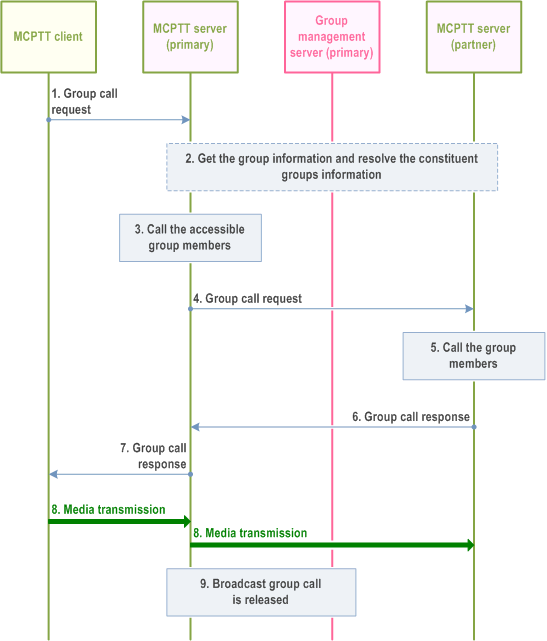
Step 1.
The MCPTT user via MCPTT client initiates a group call for a broadcast temporary group with an MCPTT group ID, temporary group indicator, and the broadcast indicator. A group call request message with the MCPTT group ID is routed to the MCPTT server of the primary MCPTT system, which owns the group and is where the authorized MCPTT user/dispatcher created the broadcast temporary group. The MCPTT group ID is a temporary MCPTT group ID.
Step 2.
The MCPTT server of the primary MCPTT system obtains the temporary group information (either from group management server or itself) including the constituent MCPTT groups' identities, accessible group members list of the constituent groups, the broadcast group type, and other related data.
Step 3.
The MCPTT server of the primary MCPTT system initiates directly a call request to the accessible group members using the detailed user information and/or location information. The group members upon receipt of the call request may accept or reject the call.
Step 4.
The MCPTT server of the primary MCPTT system may not have access to group members' information of the constituent group belonging to the partner MCPTT system. For such group members, the MCPTT server of the primary MCPTT system initiates a group call request message to the MCPTT server of the partner MCPTT system with the target group's MCPTT group ID information.
Step 5.
The MCPTT server of the partner MCPTT system further initiates a call request to the clients of the constituent group's members as described in step 3.
Step 6.
The MCPTT server of the partner MCPTT system provides a group call response to the MCPTT server of the primary MCPTT system with success or failure result and/or detailed reason information if there is a failure.
Step 7.
The MCPTT server of the primary MCPTT system provides a group call response message to the MCPTT client of the affiliated MCPTT user upon receiving responses to the call requests sent to members of primary and partner MCPTT systems. The group call response message will consist of the success or failure result and/or detailed reason information if there is a failure.
Step 8.
Upon successful call setup completion a broadcast group call is established for the group members from constituent groups of multiple MCPTT servers. The call originating MCPTT user starts transmitting media to other group call participants. The media is also distributed to the partner MCPTT system.
Step 9.
At the completion of the media transmission, the broadcast temporary group call is released.